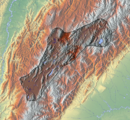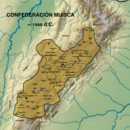Herrera Period
 |
| Part of a series on |
| Muisca culture |
|---|
| Topics |
| Geography |
| The Salt People |
| Main neighbours |
| History and timeline |



The Herrera Period is a phase in the history of Colombia. It is part of the Andean preceramic and ceramic, time equivalent of the North American pre-Columbian formative and classic stages and age dated by various archaeologists.[1] The Herrera Period predates the age of the Muisca, who inhabited the Altiplano Cundiboyacense before the Spanish conquest of the Muisca and postdates the prehistory of the region in Colombia. The Herrera Period is usually defined as ranging from 800 BCE to 800 CE,[2] although some scholars date it as early as 1500 BCE.[3]
Ample evidence of the Herrera Period has been uncovered on the Altiplano Cundiboyacense. The main archaeologists contributing to the present knowledge about the Herrera Period are the scholars Ana María Groot, Gonzalo Correal Urrego, Thomas van der Hammen, Carl Henrik Langebaek Rueda, Sylvia M. Broadbent, and Marianne Cardale de Schrimpff.
Etymology
The Herrera Period is named after Lake Herrera (Laguna de la Herrera) where archaeologist Silvia Broadbent performed the first excavations on the Herrera Period in 1971. Lake Herrera is one of the many remnants of the ancient Lake Humboldt, a Pleistocene lake that existed on the Bogotá savanna. The lake with an approximate surface area of 280 hectares (30,000,000 sq ft) is situated at an altitude of 2,550 metres (8,370 ft) within the boundaries of the Cundinamarca municipality Mosquera, close to Madrid and Bojacá.[4] The site of Lake Herrera (Laguna de la Herrera) is close to the archaeological site of Aguazuque.[5]
Background
The region of the Herrea Period and later Muisca Confederation, the Altiplano Cundiboyacense; high plateau of the central Colombian Andes has been inhabited since 12,400 years BP. The earliest evidence for inhabitation (lithic tools) are found in El Abra and Tequendama.[6] This lithic period is roughly defined as from 12,400 to 1000 BCE.[7] Later sites are Aguazuque and Checua.
Agriculture started around 5000 years before present which led to the development of more complex societies, of which the Herrera Period is one of many in the Andean civilizations. Early evidence of inhabitation has been found in Zipacón and is dated at 3270 BCE.[8] From the Herrera Period ceramic has been found.[9] The oldest ceramic evidence found dates to 2500 BP (500 BCE), except for one piece found near Tocarema and dated at 2750 BP.[10]
The people from the Herrera Period performed agriculture, as evidenced in among others the Thomas van der Hammen Reserve, named after Dutch geologist and botanist Thomas van der Hammen.[11]
The Late Herrera Period coincides with the Nahuange Period (200-900) of the Tairona.[12]
Archaeological sites
Archaeological evidence of the Herrera Period has been found in numerous places on the Altiplano Cundiboyacense, among others in Sopó,[13] Soacha,[14][15] Usme,[16] Iza, Gámeza,[17] Facatativá (Piedras del Tunjo Archaeological Park), Moniquirá (El Infiernito), Chía,[18] Chita, Chiscas, Soatá, Jericó, Sativasur, Covarachía, Sativanorte and El Cocuy.[19]
The site in Soacha is one of the most important finds from the Herrera Period, dating from 400 BCE onwards, into the age of the Muisca.[20][21] At the site the remains of 2200 individual people, 274 complete ceramic pots, stone tools, seeds of cotton, maize, beans and curuba, 634 fragmented and intact spindles and 100 tunjos not used for offerings have been found in Soacha.[21]
Timeline
| Timeline of inhabitation of the Altiplano Cundiboyacense, Colombia | |
 |
   |
Classifications
Over the years and based on new findings, various authors have defined periods of Herrera and Muisca. Regional variations also exist, listed below.
| Author | Name | Start age | End age | Notes |
|---|---|---|---|---|
| Romano, 2003 | Early Herrera | 900 BCE | 0 | [1][22] |
| Late Herrera | 0 | 700 | ||
| Early Muisca | 700 | 1100 | ||
| Late Muisca | 1100 | 1600 | ||
| Kruschek, 2003 | Herrera | 800 BCE | 800 | [1][23] |
| Early Muisca | 800 | 1200 | ||
| Late Muisca | 1200 | 1600 | ||
| Boada, 2003 | Herrera | 300 BCE | 200 | [1] |
| Early Muisca | 200 | 1000 | ||
| Late Muisca | 1000 | 1600 | ||
| Cárdenas & Kleef, 1996 | Herrera | 1500 BCE | 800 | [24] |
| Muisca | 800 | 1600 | ||
| Peña, 1991 | Early Herrera | 14th century BCE | 4th century BCE | [1] |
| Middle Herrera | 4th century BCE | 1st century CE | ||
| Late Herrera | 6th century CE | 10th century CE | ||
| Early Muisca | ||||
| Late Muisca | ||||
| Langebaek, 1986 | Herrera | [1] | ||
| Muisca | ||||
| Modern | ||||
| Schrimpff, 1981 | Herrera | 400 BCE | 200 | [1] |
| Muisca | 1400 | 1500 | ||
Regional variations
Western slopes of the Eastern Ranges
| Author | Name | Start age | End age | Notes |
|---|---|---|---|---|
| Argüello, 2004 | Herrera | 800 BCE | 800 | [1] |
| Pubenza | 800 | 1000 | ||
| Late Period | 1000 | 1550 | ||
| Modern | >1550 | |||
| Schrimpff, 1976 | Period I | 750 | 1200 | [1] |
| Period II | 1200 | 1550 | ||
Boyacá
| Author | Name | Start age | End age | Notes |
|---|---|---|---|---|
| Langebaek, 2001 | Herrera | 400 BCE | 700 | [1] |
| Late Herrera | 700 | 1000 | ||
| Early Muisca | 1000 | 1200 | ||
| Late Muisca | 1200 | 1600 | ||
| Modern | >1600 | |||
| Boada, 2007 | Late Herrera | 700 | 1000 | [1] |
| Early Muisca | 1000 | 1300 | ||
| Late Muisca | 1300 | 1600 | ||
See also
References
- ^ a b c d e f g h i j k Template:Es Chronology of pre-Columbian periods: Herrera and Muisca
- ^ Kruschek, 2003
- ^ Langebaek, 1995, Ch. 4, p. 70
- ^ Template:Es Herrera Lake
- ^ Correal Urrego, 1990, p. 87
- ^ Correal Urrego, 1990, p. 29
- ^ Template:Es Lithic Period in Engativá
- ^ Nieto Escalante et al., 2010, p. 96
- ^ Template:Es Herrera Period evidence in Boyacá
- ^ Argüello García, 2015, p. 56
- ^ Template:Es Herrera Period agriculture at the Thomas van der Hammen Reserve
- ^ Template:Es Tairona at the Museo del Oro, Bogotá
- ^ Template:Es Herrera Period evidence in Sopó
- ^ Template:Es Herrera Period evidence in Soacha – El Espectador
- ^ Template:Es Largest Herrera Period village in Soacha
- ^ Template:Es Herrera Period evidence in Usme – El Tiempo
- ^ Template:Es Herrera Period evidence in Iza and Gámeza
- ^ Cardale Schrimpff, 1985, p. 104
- ^ Cárdenas & Kleef in Reyes Zambrano, 1995, Ch. 2.1.3
- ^ Adriaan Alsema, Archaeologists uncover remains of pre-Columbian village in central Colombia. November 1, 2014
- ^ a b Template:Es Dating of the Soacha Herrera Period site
- ^ Argüello García, 2015, p. 38
- ^ Template:Es Herrera Period – Universidad Nacional de Colombia
- ^ Template:Es El páramo: ecosistema de alta montaña, Chapter 2.1.3 – Banco de la República
Bibliography
- Template:Cite LSA
- Template:Cite LSA
- Template:Cite LSA
- Template:Cite LSA
- Template:Cite LSA
- Template:Cite LSA
- Template:Cite LSA

